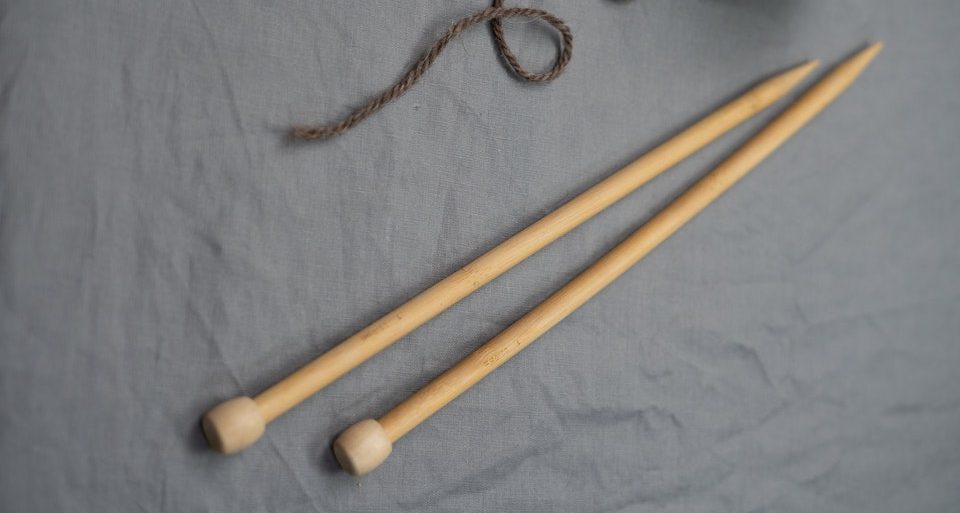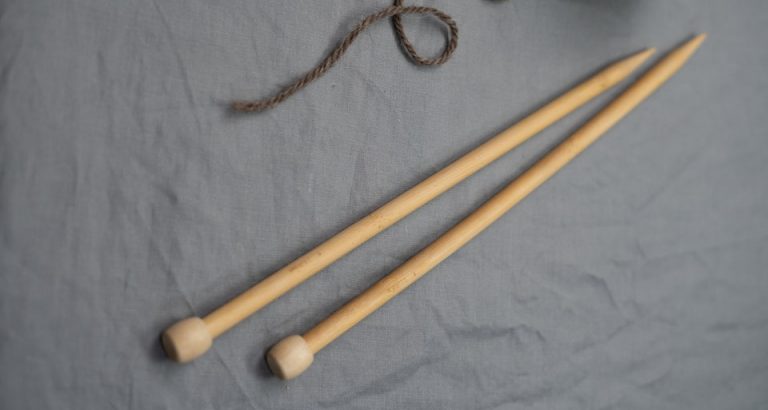We recently did an article on different types of knitting needles. However, we didn’t discuss the material of the needles. In this article we will talk about the main materials used, such as bamboo, metal and plastic, and delve into the pros and cons of the different knitting needle materials.
For all needles, accessories and yarn you need, check out our webshop!

Bamboo (Wooden) Knitting Needles
A very popular option is bamboo knitting needles, often also referred to as wooden knitting needles. These needles are solid and slightly heavy, and the surface has a bit of a grip. Other hardwoods are also used, but not as frequently, and have similar properties.
Pros
- Bamboo knitting needles are great for beginners and those that like to knit slowly and steadily. The grip of the wooden surface makes sure that your yarn doesn’t slip off the needle.
- Bamboo needles are also easy to find everywhere and they are fairly inexpensive, so it is easy to pick up a set of these needles!
Cons
- If you like to knit quickly, you might find that bamboo or wooden knitting needles slow you down a little bit. Also, because the tip can be a bit blunt, these needles can lack the precision of needles made from other materials.
Aluminum (Metal) Knitting Needles
When we talk about metal knitting needles, we usually refer to aluminum, which is the most common metal used for making knitting needles . However, less frequently used metals like steel can also be used. Aluminum needles are solid but lightweight . They have a smooth surface and typically a fairly pointy tip.
Pros
- In contrast to bamboo knitting needles, the slick surface of aluminum needles allows knitters to knit quickly.
- They are also very sturdy and difficult to break, making them especially useful when knitting with very thin needles. The sharper needle tips make it great for working with fine yarns like lace weight.
Cons
- The slippery surface can be a challenge for beginner knitters, and can also be inconvenient when knitting with slippery yarns like bamboo.
- They are slightly more expensive than the bamboo needles, but if you shop around, you should be able to find reasonably priced brands.
Plastic Knitting Needles
The surface of plastic knitting needles meets somewhere in the middle between bamboo and aluminum. They have a smooth surface, but not too slippery. The material is also very lightweight.
Pros
- Plastic knitting needles are great for beginners to learn how to knit because they are both easy to use and very affordable.
- The fact that they are so lightweight also makes them great for jumbo sized needles, and when working on heavy projects.
Cons
- These needles can bend and warp. Some knitters might also find they don’t quite keep as nice to hold as needles made from other materials. They also have a more rounded tip, like bamboo knitting needles, which might be frustrating for certain types of projects.
Carbon Fibre (?!) Knitting Needles
Things are getting high tech! Some companies are now making knitting needles from materials like carbon fibre. These are slightly more grippy than metal knitting needles and super durable.
Pros
- Their durability would probably last you a lifetime. Plus, it just sounds so cool to have carbon fibre knitting needles!
Cons
- Carbon fibre is not as easy to find as the more common needle materials, and this also makes them a bit more expensive as well.
What Knitting Needle Materials Are Best?
Different knitters have different preferences when it comes to knitting needle material. Therefore we won’t be able to tell you if bamboo knitting needles are better than metal needles, or vice versa.
If you are a long time knitter, you have probably already made up your mind about your favorite. However, if you are a beginner, I recommend trying some different needles to see what suits you best!
Also, check out our Knit&Note app, with everything you need for knitting – in one place. It is easy to use, and also offers a community of knitters!




